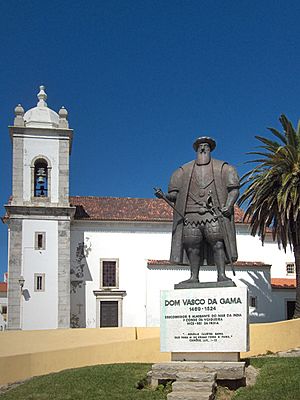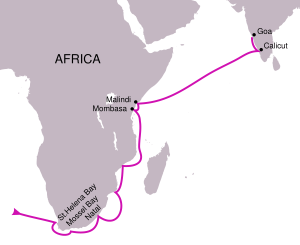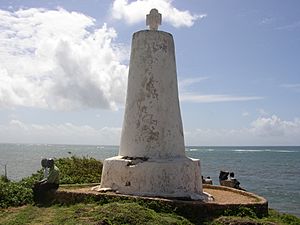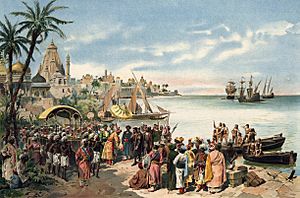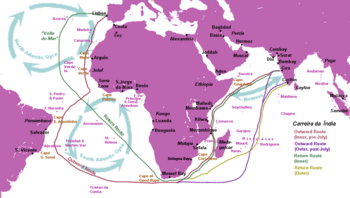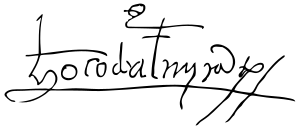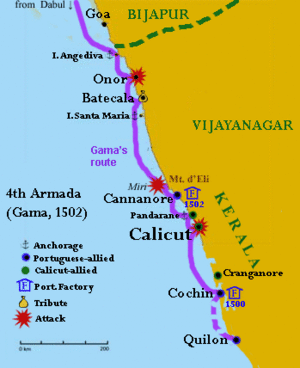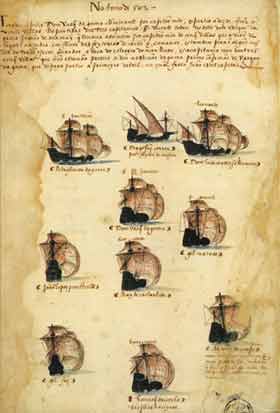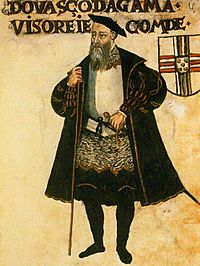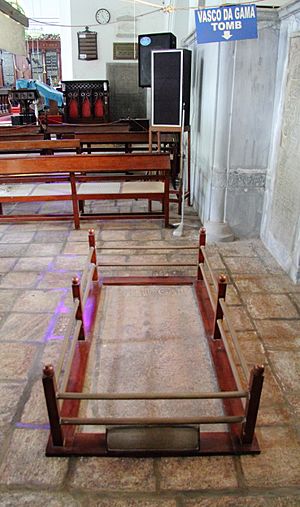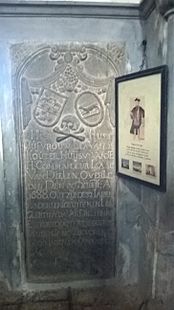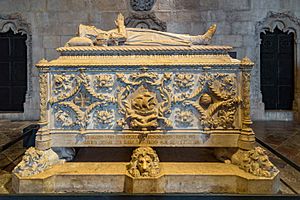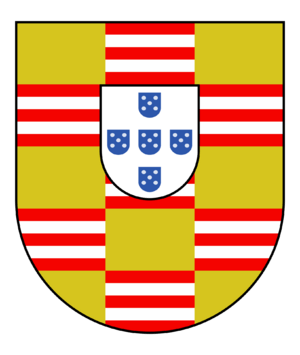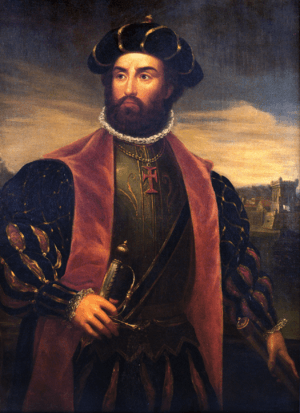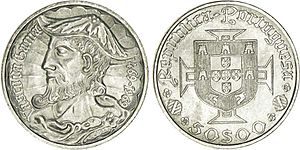Vasco da Gama facts for kids
Quick facts for kids
Vasco da Gama
|
|
|---|---|
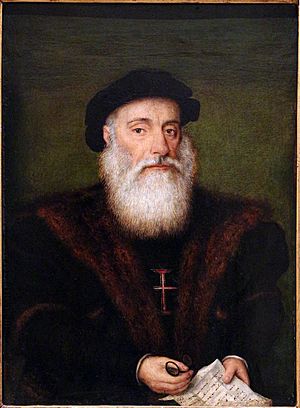 |
|
| Viceroy of Portuguese India | |
| In office 5 September 1524 – 24 December 1524 |
|
| Monarch | John III of Portugal |
| Preceded by | Duarte de Menezes |
| Succeeded by | Henrique de Menezes |
| Personal details | |
| Born | 1460 or 1469 Sines, Alentejo, Kingdom of Portugal |
| Died | 24 December 1524 (aged approximately 55–65) Cochin, Kingdom of Cochin |
| Resting place | Jerónimos Monastery, Lisbon, Portugal |
| Spouse | Catarina de Ataíde |
| Children | Francisco da Gama, 2nd Count of Vidigueira Estêvão da Gama, Governor of India Cristóvão da Gama, Captain of Malacca Among others |
| Parents |
|
| Occupation | Explorer, Viceroy of India |
| Signature |  |
Vasco da Gama (born around 1460s – died December 24, 1524) was a famous Portuguese explorer. He was the first European to reach India by sailing around Africa.
His first journey to India (1497–1499) was a huge step in world history. It connected Europe and Asia by an ocean route for the first time. This linked the Atlantic and Indian oceans, joining the Western and Eastern parts of the world. This journey helped start a new era of global connections. It also allowed Portugal to build a lasting colonial empire from Africa to Asia. However, da Gama and those who followed him also used harsh methods, which gave the Portuguese a brutal reputation in India. This set a pattern for European colonialism during the Age of Exploration.
Sailing this ocean route meant the Portuguese could avoid the dangerous Mediterranean and the Arabian Peninsula. This first expedition was the longest ocean journey ever made at that time. After many years of explorers trying to reach India, da Gama finally landed in Calicut on May 20, 1498. This gave Portugal direct access to the valuable spice trade routes in India. Spices like pepper and cinnamon, new to Europe, greatly boosted the economy of the Portuguese Empire. Portugal kept control of this trade for many decades. Later, other European countries like the Dutch Republic and England challenged Portugal's power.
Vasco da Gama led two major Portuguese fleets to India. For his important work, he was made Governor of India with the title of Viceroy in 1524. He also became the Count of Vidigueira in 1519. He is still a very important figure in the history of exploration. Many places and things around the world are named after him. The famous Portuguese poem, Os Lusíadas, was written in his honor. In 2016, many old items were found from the shipwreck of the Esmeralda, one of da Gama's ships, off the coast of Oman.
Contents
Early Life
Vasco da Gama was born around 1460 in Sines, a seaport in southwest Portugal. His father was Estêvão da Gama, a knight who served a Portuguese prince. His father was also the civil governor of Sines for a time.
Vasco's mother was Isabel Sodré. Her family was well-known and connected to important military groups. Vasco was the third of five sons. He also had a sister. Not much is known about his early life. Some historians think he studied in the town of Évora, where he might have learned about math and navigation.
Around 1480, da Gama joined the Order of Santiago, a military group. The leader of this group became King John II of Portugal in 1481. King John II liked the Order, and this helped the da Gama family. In 1492, King John II sent da Gama on a mission to capture French ships. Da Gama did this quickly and well.
Exploration Before Da Gama
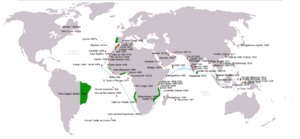
Since the early 1400s, Portuguese explorers had been sailing down the coast of Africa. These trips were started by Prince Henry the Navigator. They were mainly looking for gold and slaves. These trips greatly increased Portugal's knowledge of the sea.
When King John II of Portugal became king in 1481, he wanted to make Portugal richer. He believed that royal trade was the key. He expanded the gold and slave trade in West Africa. He also wanted to join the very profitable spice trade between Europe and Asia. This trade was mostly controlled by Venice, using land routes through the Red Sea to India. King John II set a new goal: to find a sea route to Asia by sailing around Africa.

By the time Vasco da Gama was in his 20s, the king's plans were close to happening. In 1487, King John II sent two spies, Pero da Covilhã and Afonso de Paiva, overland to East Africa and India. They were to gather information about the spice markets. The big breakthrough came soon after. In 1488, King John II's captain Bartolomeu Dias successfully sailed around the Cape of Good Hope. He explored as far as the Fish River in South Africa. This showed that the coast continued to the northeast.
An explorer was needed to connect Dias's findings with those of da Covilhã and de Paiva. This would create a valuable trade route across the Indian Ocean.
First Voyage
On July 8, 1497, Vasco da Gama led a fleet of four ships with 170 men from Lisbon. The journey around Africa to India and back was longer than the Earth's equator. The navigators were very experienced. About 55 men returned, and two ships were lost. Two of the ships were large carracks, built for the trip. The others were a smaller caravel and a supply boat.
The four ships were:
- São Gabriel, commanded by Vasco da Gama.
- São Rafael, commanded by his brother Paulo da Gama.
- Berrio (also called São Miguel), a caravel, commanded by Nicolau Coelho.
- A supply ship, commanded by Gonçalo Nunes, which was later sunk in South Africa.
Journey to the Cape
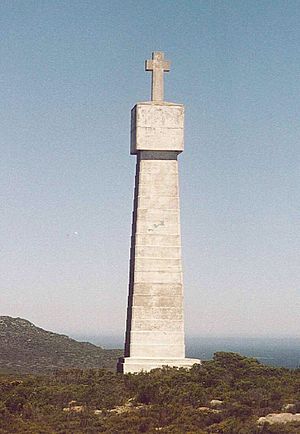
The expedition sailed from Lisbon on July 8, 1497. They followed the coast of Africa past Tenerife and the Cape Verde Islands. After reaching Sierra Leone, da Gama sailed south into the open ocean. He was looking for the South Atlantic westerlies winds that Bartolomeu Dias had found. This route worked, and on November 4, 1497, they reached the African coast. For over three months, the ships had sailed more than 6,000 miles (9,700 km) without seeing land. This was the longest journey out of sight of land at that time.
By December 16, the fleet had passed the Great Fish River in South Africa, where Dias had stopped. They sailed into waters no European had seen before. Because Christmas was coming, da Gama and his crew named the coast they passed Natal, meaning "birth of Christ" in Portuguese.
Mozambique
Vasco da Gama stayed near Mozambique Island from March 2 to 29, 1498. The East African coast was part of a large trade network in the Indian Ocean, controlled by Arabs. Da Gama pretended to be a Muslim to meet the Sultan of Mozambique. However, his trade goods were not impressive, and the local people became suspicious. Forced to leave Mozambique, da Gama fired his cannons at the city as he left.
Mombasa
Near modern Kenya, the expedition started acting like pirates. They robbed Arab merchant ships, which usually had no weapons. The Portuguese were the first Europeans known to visit the port of Mombasa from April 7 to 13, 1498. But they were not welcomed and soon left.
Malindi
Vasco da Gama continued north and arrived at the friendlier port of Malindi on April 14, 1498. The leaders of Malindi were in conflict with Mombasa. Here, the expedition first saw signs of Indian traders. Da Gama and his crew hired a pilot who knew about the monsoon winds. This pilot guided them the rest of the way to Calicut in India.
Calicut, India
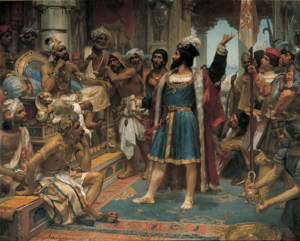

The fleet arrived near Kozhikode (Calicut) on the Malabar Coast of India on May 20, 1498. The King of Calicut, the Zamorin, returned to the city when he heard about the foreign ships. Da Gama was welcomed with traditional hospitality, including a large procession. However, his meeting with the Zamorin did not go well. When asked why they came, they said they were "in search of Christians and spices." The gifts da Gama offered were not impressive, and Muslim merchants, who saw da Gama as a rival, suggested he was just a pirate.
The King refused da Gama's request to leave a trading agent behind. He insisted that da Gama pay customs duty, like any other trader. This made relations tense. Annoyed, da Gama forcibly took some local people with him when he left.
Return Journey
Vasco da Gama left Calicut on August 29, 1498. He was eager to go home and ignored advice about the monsoon winds. The journey back across the Indian Ocean was very difficult. On the way to India, it took only 23 days. But on the return trip, sailing against the wind, it took 132 days.
Da Gama saw land again on January 2, 1499, passing the city of Mogadishu in Africa. His fleet finally reached Malindi on January 7, 1499. They were in terrible shape. About half of the crew had died, and many others were sick with scurvy. With not enough men to sail three ships, da Gama ordered the São Rafael to be sunk. The remaining crew moved to the São Gabriel and the Berrio.
The rest of the journey was smoother. By early March, they reached Mossel Bay and crossed the Cape of Good Hope on March 20. They reached the west African coast by April 25.
The Berrio, commanded by Nicolau Coelho, separated from da Gama's ship and arrived in Lisbon on July 10, 1499. Coelho delivered the news to King Manuel I. Meanwhile, da Gama's brother, Paulo da Gama, became very ill. Vasco stayed with him on Santiago island and sent the São Gabriel home with his clerk. Paulo da Gama died on the way back to Portugal. Vasco da Gama buried his brother in the Azores and grieved there. He finally arrived in Lisbon in late August or early September 1499.
Despite his sadness, da Gama was celebrated as a hero. He received many honors, including a parade. King Manuel wrote letters describing da Gama's first voyage.
The expedition was costly. Two ships and over half the men were lost. It also failed to get a trade agreement with Calicut. However, the small amounts of spices and goods brought back showed that future trade could be very profitable. Vasco da Gama was rightly praised for opening a direct sea route to Asia. This path would be used by yearly Portuguese fleets to India.
The spice trade became very important for Portugal's royal treasury. Da Gama's voyage also showed that the east coast of Africa was vital for Portuguese interests. Its ports offered fresh water, supplies, and places for ship repairs. This led to Portugal colonizing Mozambique.
Rewards
In December 1499, King Manuel I of Portugal rewarded Vasco da Gama with the town of Sines. This was a complicated gift because Sines belonged to a military group called the Order of Santiago. Da Gama spent years trying to gain control of Sines. This led him to leave the Order of Santiago and join the rival Order of Christ in 1507.
Meanwhile, da Gama received a large payment from the king. He was also given the noble title of Dom (lord) for himself and his family forever. On January 30, 1502, da Gama was given the title of "Admiral of the Seas of Arabia, Persia, India and all the Orient." This grand title was similar to the one held by Christopher Columbus. Another royal letter gave da Gama the right to play a key role in any future fleets going to India.
Around 1501, Vasco da Gama married Catarina de Ataíde. She came from a noble family connected to powerful people.
Second Voyage
The next expedition to India in 1500, led by Pedro Álvares Cabral, aimed to make a treaty with the Zamorin of Calicut. However, Cabral had a conflict with local Arab merchants. The Portuguese trading post was attacked, and many Portuguese were killed. Cabral blamed the Zamorin and attacked the city. This started a war between Portugal and Calicut.
Vasco da Gama took command of the 4th India Armada, which sailed in 1502. His goal was to get revenge on the Zamorin and force him to agree to Portuguese terms. This heavily armed fleet of fifteen ships and 800 men left Lisbon on February 12, 1502. It was a family affair for da Gama, with his uncles and brothers-in-law commanding ships.
On the way, da Gama's fleet made contact with the gold trading port of Sofala in East Africa. They also forced the sultanate of Kilwa to pay them a large amount of gold.
Pilgrim Ship Incident
When da Gama's fleet reached India in October 1502, they stopped a ship called Mirim. This ship was carrying over 400 Muslim pilgrims, including women and children, from Calicut to Mecca. Da Gama's men looted the ship. They locked the passengers inside and set the ship on fire, killing most of them. Some children were saved but forced to convert to Christianity. This act showed the extreme violence used by da Gama.
Calicut
After stopping at Cannanore, da Gama's fleet sailed to Calicut. He demanded payment for the attack on Cabral's trading post. The Zamorin, knowing what happened to the pilgrim ship, wanted to make peace. But da Gama demanded that the Hindu king expel all Muslims from Calicut before talking. The Zamorin refused.
The Zamorin secretly sent a message to a nearby ruler, asking for help against the Portuguese. This message was given to da Gama, which made him believe the Indians were untrustworthy. Da Gama then called the Zamorin's high priest a spy. He ordered the priest's lips and ears to be cut off, and dog's ears sewn to his head, before sending him away. The Portuguese fleet then attacked the city with cannons for almost two days, causing much damage. Da Gama also captured several rice ships. He cut off the hands, ears, and noses of the crew members. He sent them back to the Zamorin with a note, saying he would be friendly if the Zamorin paid for the stolen goods and the gunpowder used.
Sea Battle
Da Gama's violent actions stopped trade along the Malabar Coast of India, which Calicut depended on. The Zamorin sent a fleet of warships to fight da Gama's fleet. But da Gama defeated them in a naval battle near Calicut harbor.
Cochin
Da Gama then loaded his ships with spices at Cochin and Cannanore. These were smaller kingdoms that were enemies of the Zamorin. Portuguese fleets had already made alliances with them. The 4th armada left India in early 1503. Da Gama left a small group of ships behind, led by his uncle Vicente Sodré. Their job was to patrol the Indian coast, continue attacking Calicut's ships, and protect the Portuguese trading posts in Cochin and Cannanore.
Vasco da Gama returned to Portugal in September 1503. He had not succeeded in making the Zamorin surrender. Because of this failure, and his uncle's failure to protect the trading post in Cochin, da Gama did not receive more rewards. When King Manuel I of Portugal chose the first governor and viceroy of Portuguese India in 1505, da Gama was passed over. The job went to Francisco de Almeida.
Later Years
For the next twenty years, Vasco da Gama lived a quiet life. He was not welcome at the royal court and was kept away from Indian affairs. His attempts to regain the favor of King Manuel I did not work. Other explorers and governors were preferred by the king.
In 1518, after Ferdinand Magellan left Portugal to work for Spain, Vasco da Gama threatened to do the same. To keep him in Portugal, King Manuel I finally gave Vasco da Gama a noble title in 1519. He became the first Count of Vidigueira. This made da Gama the first Portuguese count who was not born into a royal family.
Third Voyage and Death
After King Manuel I died in late 1521, his son, King John III of Portugal, became king. John III wanted to change how Portugal governed its overseas lands. He decided to appoint Vasco da Gama to replace the current governor of Portuguese India, Duarte de Menezes, who was seen as incompetent. King John III hoped that da Gama's famous name would help him bring order to Portuguese India.
In February 1524, King John III gave Vasco da Gama the special title of "Viceroy". He was only the second Portuguese governor to have this title. His second son, Estêvão da Gama, was also appointed commander of the Indian Ocean naval fleet.
Vasco da Gama set sail in April 1524 with a fleet of fourteen ships. Two of his sons, Estêvão and Paulo, went with him. After a difficult journey where some ships were lost, he arrived in India in September. Vasco da Gama immediately used his power as Viceroy to make changes in Portuguese India. He replaced many old officials with his own choices. However, da Gama became sick with malaria soon after arriving. He died in the city of Cochin on Christmas Eve in 1524, just three months after his arrival.
As the king had planned, da Gama was replaced as governor by Henrique de Menezes. Da Gama's sons lost their positions and returned to Portugal in early 1525.
Vasco da Gama's body was first buried at St. Francis Church in Kochi. But his remains were returned to Portugal in 1539. His body was re-buried in Vidigueira in a special casket.
The Monastery of the Hieronymites in Belém, Lisbon, was built in the early 1500s near where Vasco da Gama's first journey began. Its construction was paid for by taxes on the profits from the yearly Portuguese India fleets. In 1880, da Gama's remains and those of the poet Luís de Camões were moved to new tombs in the monastery's church. They are only a few meters away from the tombs of the kings he served.
Family
Vasco da Gama and his wife, Catarina de Ataíde, had six sons and one daughter:
- Dom Francisco da Gama, who inherited his father's titles.
- Dom Estevão da Gama, who later became governor of India.
- Dom Paulo da Gama, who was killed in a naval battle.
- Dom Cristovão da Gama, who was executed during a war in Ethiopia.
- Dom Pedro da Silva da Gama.
- Dom Álvaro d'Ataide da Gama.
- Dona Isabel d'Ataide da Gama, his only daughter.
Legacy
Vasco da Gama is one of the most famous explorers from the Age of Discovery. He played a huge role in Portugal becoming a powerful colonizing nation. His smart mix of politics and warfare helped Portugal gain a strong position in Indian Ocean trade. After his first voyage, the Portuguese realized that having outposts on the eastern coast of Africa was vital for their trade routes to Asia.
However, his fame is also connected to incidents like the violent attack on the pilgrim ship.
The Portuguese national epic poem, the Lusíadas by Luís Vaz de Camões, is mostly about Vasco da Gama's voyages.
The port city of Vasco da Gama in Goa, India, is named after him. There is also a crater on the Moon called Vasco da Gama. Three football clubs in Brazil and one in Goa are named after him. There is a church in Kochi, India, called Vasco da Gama Church.
Several places in Lisbon, Portugal, are named after the explorer. These include the Vasco da Gama Bridge, Vasco da Gama Tower, and a shopping center. The Oceanário has a mascot named "Vasco" after him.
The Portuguese Navy has a class of frigates named after him.
In March 2016, archaeologists found a shipwreck off the coast of Oman. They believe it is the Esmeralda from da Gama's 1502–1503 fleet. They identified the ship using artifacts like a rare Portuguese coin and stone cannonballs with the initials of Vicente Sodré, da Gama's uncle.
Images for kids
Error: no page names specified (help).
- Chronology of European exploration of Asia
See also
 In Spanish: Vasco da Gama para niños
In Spanish: Vasco da Gama para niños


